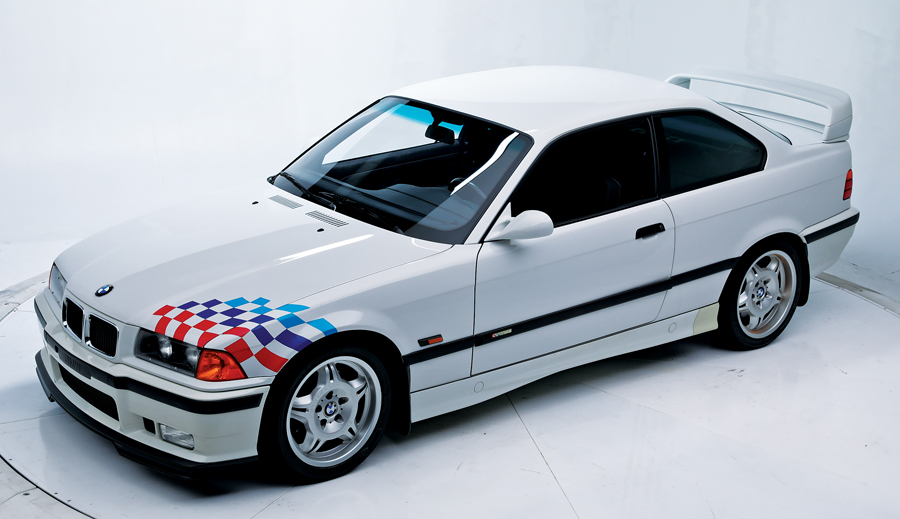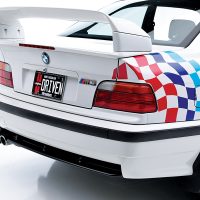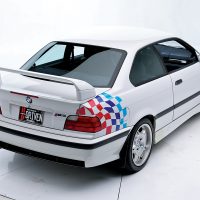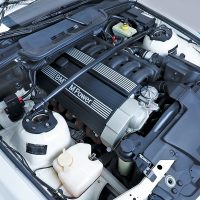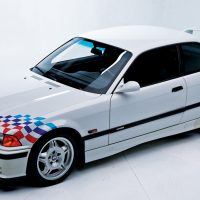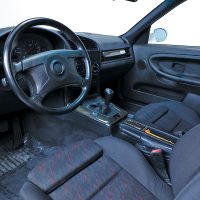SCM Analysis
Detailing
| Vehicle: | 1995 BMW M3 Lightweight |
| Years Produced: | 1995 |
| Number Produced: | 126 |
| Original List Price: | $48,470 (base) |
| SCM Valuation: | $121,000 |
| Tune Up Cost: | $800 |
| Chassis Number Location: | On the dashboard near the lower left windshield, on the end of the left front door and on the gear housing |
| Engine Number Location: | Under the inlet manifold |
| Club Info: | BMW Car Club of America |
| Website: | http://www.bmwcca.org |
| Alternatives: | 1996–97 Porsche 993 Twin Turbo, 1994 BMW M3-R, 1994 BMW M3 GT |
| Investment Grade: | C |
This car, Lot 1371, sold at $385,000, including buyer’s premium, at Barrett-Jackson’s Scottsdale, AZ, auction on January 18, 2020.
I’ve never understood the draw of celebrity-owned cars. I mean, why would you want one? The owner’s celebrity doesn’t imbue the car with special driving characteristics. Nor do the cars take on any of their owners’ chiseled good looks — they look the same as variants we plebeians drive. And unless I’ve gravely misunderstood the laws of the afterlife, I’m pretty certain the deceased star’s ghost doesn’t come with the car, either.
This is why it irked me to watch a 1995 BMW M3 Lightweight formerly owned by “Fast & Furious” movie franchise star Paul Walker sell for $385,000 when it crossed the auction block at Barrett-Jackson Scottsdale in January.
“Fast & Furious” is Famous & Rich
Walker played leading man in seven of the “Fast & Furious” movies before his untimely death in November 2013. Since his demise, Walker’s celebrity has arguably risen to quasi-legendary status — in segments of the car community, at least.
The “Fast & Furious” franchise did for street racing what Marlon Brando’s 1953 film “The Wild One” did for leather-clad biker gangs: It made a bunch of outsiders mainstream. Because of Walker and his “Furious” cohort, illegal street racing — and all the obnoxious modifications and accoutrements that go with it — spread across the U.S. like wildfire.
For years following the release of “Fast & Furious,” you couldn’t pass a high school or mall parking lot without a sea of slammed VW Jettas and Acura Integras assaulting your senses. Covered in Day-Glo livery and barking away with cheap Chinese coffee-can cat-back exhaust systems, the” Furious” fanboy cars had about all the subtlety of Flamin’ Hot Cheetos.
But this is a bone I’ll pick another day — or maybe in a few paragraphs. The inflated price this M3 Lightweight fetched — simply for having been celebrity-owned — is my real beef with this auction.
Before we get to that, though, let’s remember why the M3 Lightweight is so special.
Fast, light and hard to find
In 1990s, the E36 3 Series was seen as a bit of a departure. It was bigger, softer and heavier than its predecessors. The M3 Lightweight was created to appease the brand’s most ardent supporters and purists — even if only a hundred or so of them.
The M3 Lightweight got BMW’s 240-horsepower S50B30 3.0-liter inline 6, along with a 5-speed manual gearbox. The E36 Lightweight is said to do a 0–60 run in 5.7 seconds on the way to a limited 147-mph top speed.
This M3’s “Lightweight” moniker involves addition and subtraction.
Engineers specified aluminum door skins, cloth seats, carbon-fiber trim, thinner sound deadening, and special lightweight carpeting. They also omitted the stereo, air conditioning, sunroof and factory toolkit. As a result, the Lightweight boasts a 2,950-pound curb weight — 220 pounds lighter than the standard M3.
However, Bimmer left some bolt-on extras neatly packaged in plastic in the trunk. These included a larger oil pan with dual pickups, a strut-tower brace, additional underbody bracing components, and a hefty rear wing.
All M3 Lightweights were finished in Alpine White III paint with tri-color checkered decals on the left front and right rear corners.
Although keen to demonstrate with the M3 Lightweight that it still had an eye on its more pared-down past, BMW only built 126 examples.
Oddly, Paul Walker owned five of them.
The Lightweight is a pleasure to drive. It has an immediacy in its throttle response that is unparalleled even by today’s supercars. It’s light on its feet (not surprisingly) but it’s not so featherweight that it feels flighty at high speeds.
The Paul Walker celebrity factor
During the past several years, a couple of M3 Lightweights crossed the auction block, fetching between $121,000 and $145,000. However, Mr. Walker’s 4,600-mile example sold for two and a half to three times what the others went for — with similar mileage.
Why? The reason is obvious: Mr. Walker’s famous rump once rested in its driver’s seat. And I just can’t wrap my head around why that matters.
My palms sweat just imagining admitting to people that I paid three times the going rate for a car because it once numbered amongst a famous person’s collection, let alone Paul Walker.
I get the appeal of some celebrity provenance. Steve McQueen was an effortlessly cool actor and an incredibly talented and fearless race-car driver. I understand how some of the cars McQueen owned could fetch a bit more money than other examples.
But Paul Walker? I don’t know.
I don’t want to speak ill of the dead, but Paul Walker wasn’t exactly an acting powerhouse or a crossover cultural icon. I can’t fathom how this Walker-owned Lightweight is worth three times more, especially considering he owned four other examples.
I think the fact that Walker owned five M3 Lightweights ultimately speaks the loudest about the place we’re currently in.
The sports-car pickings from the 1990s are pretty slim. The few exciting breakout models, such as the M3 Lightweight and Toyota Supra Twin Turbo, for example, aren’t really worth the prices at which they’re transacting. They’re really just a couple of bright spots in an otherwise pretty dark and dreary era.
So consider this auction emblematic of the lackluster 1990s rather than an expression of Walker’s greatness. Walker was no Steve McQueen. ♦
